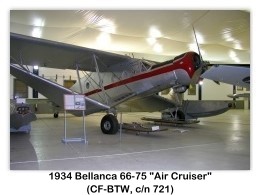

























Bellanca 66-75 "Aircruiser"
United States — eleven-fourteen passenger commercial sesquiplane
Archive Photos
Bellanca 66-75 "Aircruiser" (CF-BTW, c/n 721) c.2004 at the Tillamook Air Museum, Tillamook, OR


Overview
- Bellanca Aircruiser
- Role: Passenger/cargo aircraft
- Manufacturer: Bellanca Aircraft Corporation
- Designed by: Giuseppe Mario Bellanca
- First flight: 1930
- Primary user: Private operators
- Number built: 23
The Bellanca Aircruiser and Airbus were high-wing, single engine aircraft built by Bellanca Aircraft Corporation of New Castle, Delaware. The aircraft was built as a "workhorse" intended for use as a passenger or cargo aircraft. It was available as land, sea or ski plane. The aircraft was powered by either a Wright Cyclone or Pratt & Whitney Hornet engine. The Airbus and Aircruiser served as both a commercial and military transport.
Design and Development
The first Bellanca Airbus was built in 1930 as the P-100. An efficient design, it was capable of carrying 12 to 14 passengers depending on the cabin interior configuration, with later versions carrying up to 15. In 1931, test pilot George Haldeman flew the P-100 a distance of 4,400 miles in a time aloft of 35 hours. Although efficient, with a cost per mile figure of 0.08 cent per mile calculated for that flight, the first Airbus didn’t sell due to its water-cooled engine.
In Service
The next model, the P-200 Airbus, was powered by a larger, more reliable air-cooled engine. One version (P-200-A) came with floats and operated as a ferry service in New York City, flying between Wall Street and the East River. Other versions included a P-200 Deluxe model, with custom interiors and seating for nine. The P-300 was designed to carry 15 passengers. The final model, the "Aircruiser," was the most efficient aircraft of its day, and would rank high amongst all aircraft designs. With a Wright Cyclone air-cooled supercharged radial engine rated at 715 hp, the Aircruiser could carry a useful load greater than its empty weight. In the mid-1930s, the Aircruiser could carry 4,000 lb payloads at a speed of between 145-155 mph, a performance that multi-engine Fokkers and Ford Trimotors could not come close to matching.
In 1934, US federal regulations outlawed single engine transports on US airlines, virtually eliminating future markets for the Aircruiser. Where the workhorse capabilities of the Aircruiser stood out was in Canada. Several of the "The Flying W", as it was commonly dubbed in Canada, were used in northern mining operations, ferrying ore, supplies and the occasional passenger into the 1970s.
Variants
Airbus
- P-100 Airbus
14-passenger monoplane powered by a 600-hp (447 kW) Curtiss Conqueror engine, one built later converted into a P-200.
- P-200 Airbus
12-passenger monoplane, nine built and one converted from P-100.
- P-300 Airbus
15-seater monoplane powered by a Wright R-1820 Cyclone engine.
- Y1C-27
United States Army Air Corps designation for four P-200 Airbuses powered by 550-hp (410 kW) Pratt & Whitney R-1860 Hornet engine. All later converted to C-27C.
- C-27A Airbus
Production version of the Y1C-27 powered by a 650-hp (485 kW) Pratt & Whitney R-1860 Hornet engine, ten built. One converted to a C-27B the rest converted to C-27Cs.
- C-27B Airbus
One C-27A re-engined with a 675-hp R-1820-17 engine.
- C-27C Airbus
Four Y1C-27s and nine of the C-27A re-engined with a 750-hp R-1820-25 engine.
Aircruiser
- Aircruiser 66-67
Improved structure modified from a P-200 with a 675-hp Wright SR-1820 Cyclone engine
- Aircruiser 66-70
An Aircruiser with a 710-hp Wright SGR-1820 Cyclone engine, five-built exported to Canada.
- Aircruiser 66-75
An Aircruiser with a 730-hp Wright Cyclone engine, three built.
- Aircruiser 66-76
A cargo-version of the Aircruiser with a 760-hp Wright Cyclone.
- Aircruiser 66-80
An Aircruiser with a 850-hp Wright Cyclone engine.
Operators
- Canada: Canadian Pacific Airlines (Aircruiser), Central Northern Airways (Aircruiser), Mackenzie Air Service (Aircruiser)
- United States: New York and Suburban Airlines (Airbus), United States Army Air Corps (Airbus)
- Mexico
- Philippines
Survivors
- The last flying Aircruiser, "CF-BTW," a 1938 model, after serving in Manitoba, is now on display at the Tillamook Air Museum, in Tillamook, Oregon.
- Another Bellanca Aircruiser, "CF-AWR" named the "Eldorado Radium Silver Express", built in 1935, is presently under restoration at the Western Canada Aviation Museum, Winnipeg.
Bellanca 66-70 Aircruiser Specifications
General Characteristics
- Crew: one, pilot
- Capacity: 16 passengers
- Length: 43 ft 4 in (13.21 m)
- Wingspan:
- Height: 11 ft 6 in (3.51 m)
- Wing area: 520 ft² (48.3 m²)
Weights
- Empty weight: 6,072 lb (2,754 kg)
- Loaded weight: 10,000 lb (4,536 kg)
Power Plant
- No. of engines: one
- Engine: Wright R-1820 Cyclone 9 9-cylinder supercharged air-cooled radial engine, 710-hp (530 kW)
Performance
- Maximum speed: 144 knots (165 mph, 266 km/h)
- Range: 608 nm (700 miles, 1,130 km)
- Service ceiling: 22,000 ft (6,700 m)
References
- Shupek, John. Photos via The Skytamer Archive, copyright © 2009 Skytamer Images. All Rights Reserved
- Wikipedia, the free encyclopedia. Bellanca Aircruiser

































































